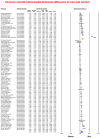Age and Sex Differences in Carotid Intima-Media Thickness: A Systematic Review and Meta-Analysis
- PMID: 39768265
- PMCID: PMC11678405
- DOI: 10.3390/life14121557
Age and Sex Differences in Carotid Intima-Media Thickness: A Systematic Review and Meta-Analysis
Abstract
Background: Ageing is a significant risk factor for carotid atherosclerosis, affecting over a billion people worldwide. Carotid intima-media thickness (cIMT) is a surrogate marker for cardiovascular disease (CVD) risk, with age- and sex-related differences in levels and progression. The onset of clinical manifestations of CVD in women is delayed by about 10 years compared to men. The present study aims to evaluate whether subclinical atherosclerosis is the same disease in men and women or two pathologies with a possible different etiology. For this purpose, we analyzed the differences in cIMT, the impact of patient characteristics, and the influence of age on cIMT in men and women.
Methods: A systematic search related to cIMT measured by an ultrasound and gender-specific differences was conducted according to the PRISMA 2020 guidelines. Ninety studies, enrolling 165,551 subjects (76,955 men and 88,553 women), were included in the quantitative synthesis.
Results: We found that men compared to women had greater common cIMT, (standardized mean difference (SMD) = 0.506, p < 0.03; I2: 98.2, p < 0.0001), greater bifurcation IMT (SMD = 1.056, p = 0.022; I2: 99.9%, p < 0.001), and higher internal cIMT (SMD = 1.124, p = 0.017; I2: 99.9%, p < 0.001). The study did not reveal any association between cardiovascular risk factors and differences in cIMT between men and women. A virtual analysis revealed that age-related cIMT is equal between sexes but postponed by 10 years in women.
Conclusions: This study showed that classical risk factors for CVD have a comparable effect on cIMT in men and women. While subclinical atherosclerotic disease, as assessed by cIMT, is essentially identical in the two sexes, it manifests itself by about 10 years later in women.
Keywords: ageing; carotid artery intima-media thickness; carotid atherosclerosis; sex difference.
Conflict of interest statement
The authors do not declare any conflicts of interest.
Figures




Similar articles
-
Impact of cardiovascular risk factors on carotid intima-media thickness: sex differences.Clin Interv Aging. 2016 May 23;11:721-31. doi: 10.2147/CIA.S103521. eCollection 2016. Clin Interv Aging. 2016. PMID: 27307718 Free PMC article.
-
Racial and Ethnic Differences in the Association Between Classical Cardiovascular Risk Factors and Common Carotid Intima-Media Thickness: An Individual Participant Data Meta-Analysis.J Am Heart Assoc. 2022 Aug 2;11(15):e023704. doi: 10.1161/JAHA.121.023704. Epub 2022 Jul 25. J Am Heart Assoc. 2022. PMID: 35876421 Free PMC article.
-
Aortic arterial stiffness associates with carotid intima-media thickness and carotid plaques in younger middle-aged healthy people.Blood Press. 2024 Dec;33(1):2405161. doi: 10.1080/08037051.2024.2405161. Epub 2024 Sep 18. Blood Press. 2024. PMID: 39291635 Clinical Trial.
-
Varying Definitions of Carotid Intima-Media Thickness and Future Cardiovascular Disease: A Systematic Review and Meta-Analysis.J Am Heart Assoc. 2023 Dec 5;12(23):e031217. doi: 10.1161/JAHA.123.031217. Epub 2023 Nov 28. J Am Heart Assoc. 2023. PMID: 38014663 Free PMC article.
-
Risk factors during first 1,000 days of life for carotid intima-media thickness in infants, children, and adolescents: A systematic review with meta-analyses.PLoS Med. 2020 Nov 23;17(11):e1003414. doi: 10.1371/journal.pmed.1003414. eCollection 2020 Nov. PLoS Med. 2020. PMID: 33226997 Free PMC article.
Cited by
-
The Effects of Smoking and Airway Restriction on Subclinical Atherosclerosis.Int J Chron Obstruct Pulmon Dis. 2025 Apr 24;20:1217-1226. doi: 10.2147/COPD.S512381. eCollection 2025. Int J Chron Obstruct Pulmon Dis. 2025. PMID: 40297844 Free PMC article.
References
-
- Song P., Fang Z., Wang H., Cai Y., Rahimi K., Zhu Y., Fowkes F.G.R., I Fowkes F.J., Rudan I. Global and regional prevalence, burden, and risk factors for carotid atherosclerosis: A systematic review, meta-analysis, and modelling study. Lancet Glob. Health. 2020;8:e721–e729. doi: 10.1016/S2214-109X(20)30117-0. - DOI - PubMed
-
- Willeit P., Tschiderer L., Allara E., Reuber K., Seekircher L., Gao L.U., Liao X., Lonn E., Gerstein H.C., Yusuf S., et al. Carotid Intima-Media Thickness Progression as Surrogate Marker for Cardiovascular Risk: Meta-Analysis of 119 Clinical Trials Involving 100 667 Patients. Circulation. 2020;142:621–642. doi: 10.1161/CIRCULATIONAHA.120.046361. - DOI - PMC - PubMed
-
- Karikkineth A.C., AlGhatrif M., Oberdier M.T., Morrell C., Palchamy E., Strait J.B., Ferrucci L., Lakatta E.G. Sex Differences in Longitudinal Determinants of Carotid Intima Medial Thickening with Aging in a Community-Dwelling Population: The Baltimore Longitudinal Study on Aging. J. Am. Hear. Assoc. 2020;9:e015396. doi: 10.1161/JAHA.119.015396. - DOI - PMC - PubMed

